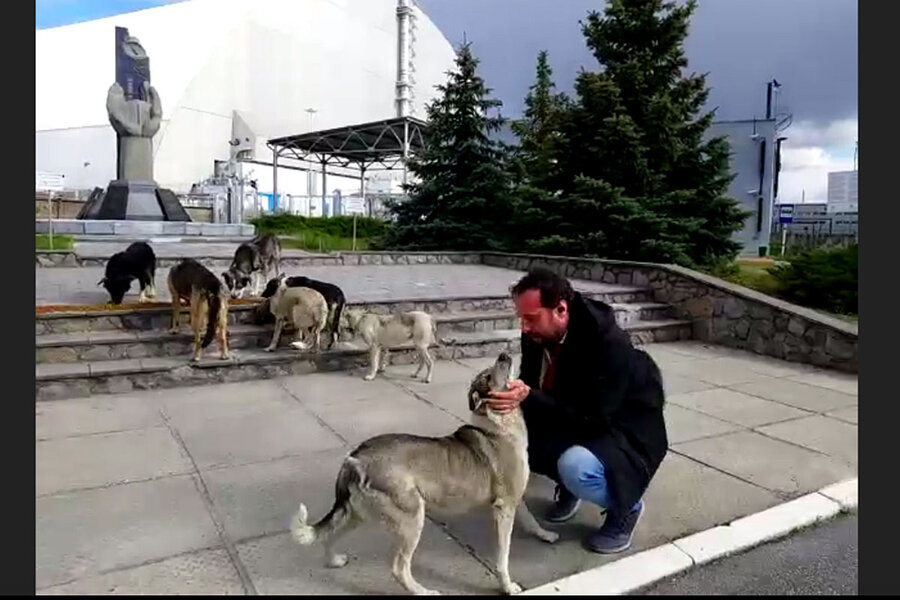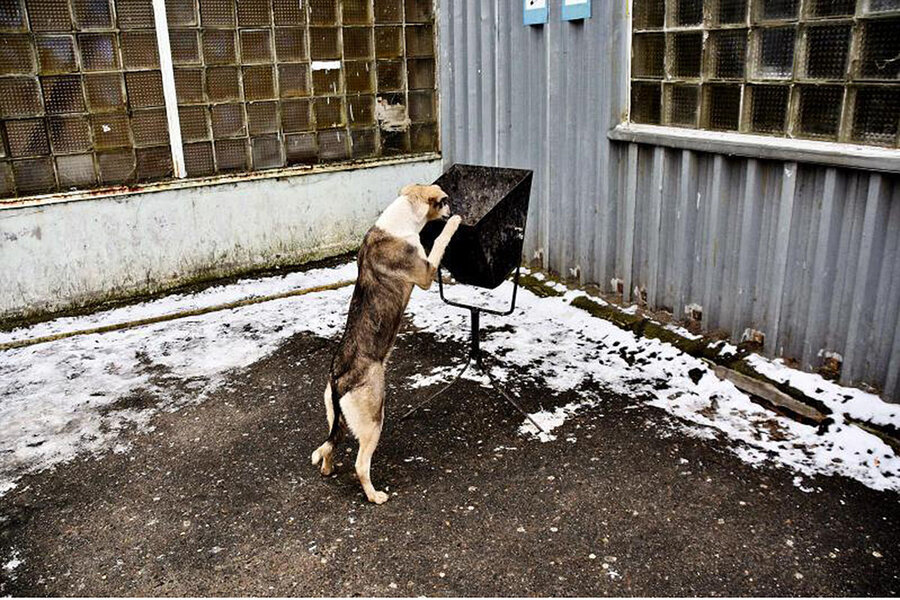The Dogs of Chernobyl: Are virtual tours the future of tourism?
Loading...
| Johannesburg
COVID-19 dealt a heavy blow to many industries, but few have been as undone as tourism. As the pandemic has worn on, tourist sites around the world have scrambled to arrange virtual versions of their offerings.
Like Airbnb’s “Dogs of Chernobyl,” a one-hour, canine-themed tour at the site of the world’s worst nuclear disaster, now available on a computer screen near you. As I watched from my home in Johannesburg, our guide in Chernobyl, Lucas Hixson, gave a virtual tour of the exploded reactor. Then he panned his phone camera down so we could catch a glimpse of a pack of shaggy stray dogs gathered near the dome’s entrance.
Why We Wrote This
Across industries, the coronavirus is inspiring innovation. In tourism, some operators are shifting from physical to virtual tours and using the opportunity to bring attention to noteworthy causes.
The dogs are the great-great-grandpups of the family dogs that residents were forced to leave behind when they were evacuated in 1986. Mr. Hixson offers tours to raise money for, and awareness about, the hundreds of stray dogs that roam the Chernobyl “exclusion zone,” the 18-mile-wide area around the power plant, where permanent human habitation is still forbidden.
“When you go through a crisis, like they did in 1986 or like we are now, the unimportant things in life fall away,” he said. “You’re left with just the stuff that really matters.”
“It’s a beautiful day here in Chernobyl,” Lucas Hixson announced one sunny afternoon last month, turning to face the group of tourists gathered in front of him.
It was a day much like this one in April 1986, he continued, when a safety test at the power plant here went awry, triggering the worst nuclear disaster in human history.
As he spoke, I looked around. It was, indeed, a perfect day. The sky was blue, and the fields on all sides a lush green. Birds chirped. Clouds floated like wisps of cotton over the decommissioned nuclear reactors in the distance.
Why We Wrote This
Across industries, the coronavirus is inspiring innovation. In tourism, some operators are shifting from physical to virtual tours and using the opportunity to bring attention to noteworthy causes.
Or at least, that’s how it all seemed from my computer screen. I was in my house in Johannesburg, and this tour, like seemingly everything else in my pandemic life, was actually a Zoom call.
Back in Chernobyl, Mr. Hixson was explaining what happened in the hours after the explosion: First responders rushed to the scene. Nearly everyone else living in the area, meanwhile, was hastily evacuated, told to take only what they needed for a three-day trip.
In truth, they would never return.
“This is a place where you can learn about the most important things in life, because the most important things are the ones people were forced to leave behind when they fled,” Mr. Hixson continued, shifting his phone camera to give his virtual audience a better view of the soaring concrete dome behind him, which was built to contain the exploded reactor.
Then he panned down so we could catch a glimpse of the real reason we were all here – a pack of shaggy stray dogs gathered near the dome’s entrance, loudly chomp-chomp-chomping their way through a small mountain of dog food. Welcome to the “Dogs of Chernobyl,” a one-hour, canine-themed tour at the site of the world’s worst nuclear disaster, now available on a computer screen near you.
Editor’s note: As a public service, all our coronavirus coverage is free. No paywall.
COVID-19 dealt a heavy blow to many industries, but few have been as thoroughly undone as tourism. As the pandemic has worn on, national parks, museums, and historic sites around the world have scrambled to arrange virtual versions of their offerings, from 360 photos to Facebook live events with experts. But few are as intimate as Airbnb’s “Online Experiences,” which brings viewers live in small groups into the kitchens of professional chefs, the home gyms of Olympic athletes, and today, the nuclear power plant in Chernobyl, Ukraine.
A few months ago, Mr. Hixson, an American specialist in nuclear decontamination who runs a nongovernmental organization called the Clean Futures Fund (CFF), was giving his tours with the dogs of Chernobyl in person. They were a way of raising money for, and awareness about, the hundreds of stray dogs that roam the Chernobyl “exclusion zone,” the 18-mile-wide area around the power plant, where permanent human habitation is still forbidden.
The dogs are the great-great-grandpups of the family dogs that residents were forced to leave behind when they were evacuated in 1986. Fleeing families tacked notes to their doorways, with pleading messages like “Don’t kill our Zhulka. She’s a good dog,” according to “Chernobyl Prayer,” a collection of oral histories. And the dogs themselves attempted to follow their humans, “howling, trying to get on the buses. Mongrels, alsatians. The soldiers were pushing them out again, kicking them. They ran after the buses for ages.” Soldiers later circled the zone, shooting any dogs they found, for fear they’d been poisoned by radioactivity.
But some survived, and nearly 40 years later, a few hundred of their scruffy descendants still roam the power plant site and the nearby workers’ town of Pripyat, where some houses still have dishes laid out and the newspaper folded on the table from the day of the evacuation.
When COVID-19 restrictions began here in late March, all in-person tours were canceled. But when Airbnb approached Mr. Hixson about moving his tour online, he was game.
Feeding a few hundred dogs daily, after all, isn’t a cheap operation. And Mr. Hixson was also looking for ways to bankroll CFF’s annual sterilization and vaccination drive, which has helped bring the population of stray dogs in Chernobyl down by several hundred over the last three years.
On a recent afternoon, he jumped out of his car in front of one of the plant’s administrative buildings. On the other end of his Zoom call that day were a bureaucrat in Tasmania, an anthropologist in Finland, and a teacher in Hong Kong. As Mr. Hixson stepped into the road, two dogs ran up to him, their tails vibrating with excitement.
He pointed to the pack, introducing today’s tour group to each dog: “That’s Sasha, Kelly, Barry, Mary, and Terry. There’s Bruiser. That’s Rosco.”
As he spread the contents of a bag of dog food onto the sidewalk in front of them, Mr. Hixson explained what he hoped today’s tour group would take away from their experience.
“When you go through a crisis, like they did in 1986 or like we are now, the unimportant things in life fall away,” he said. “You’re left with just the stuff that really matters.”
At his feet, a scruffy German Shepherd poked her long wet nose up toward the camera, her tail swishing as if in silent agreement.
Editor’s note: As a public service, all our coronavirus coverage is free. No paywall.











